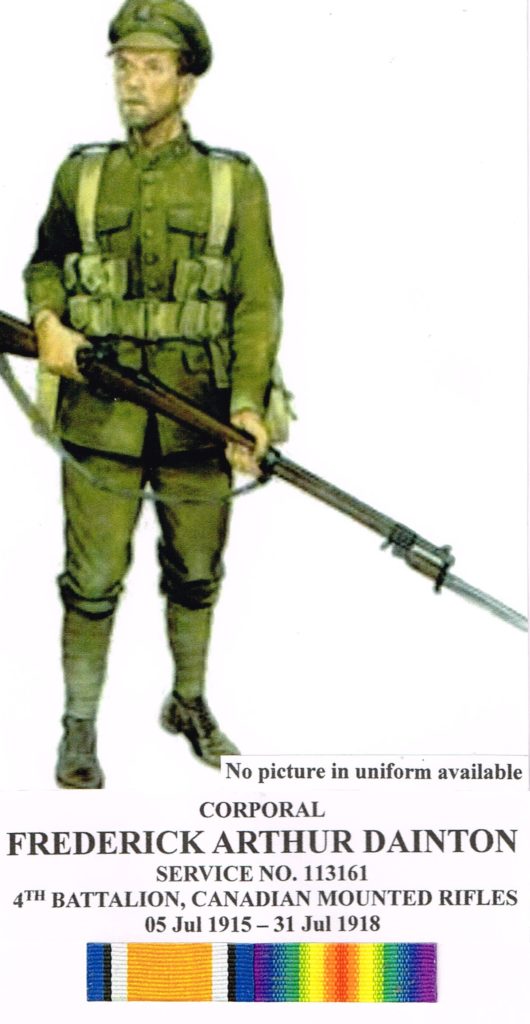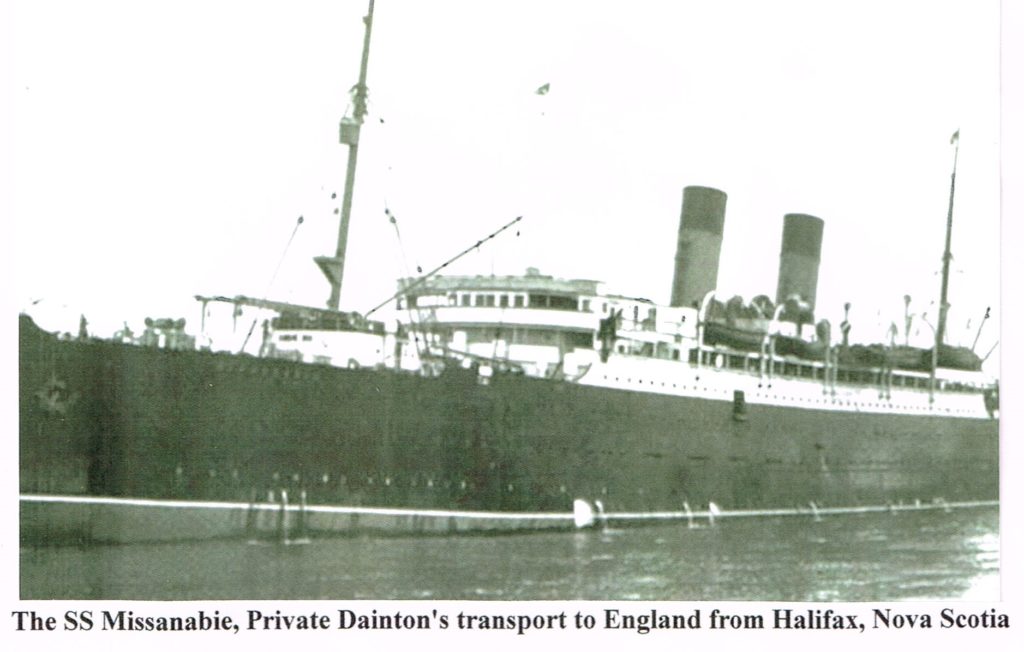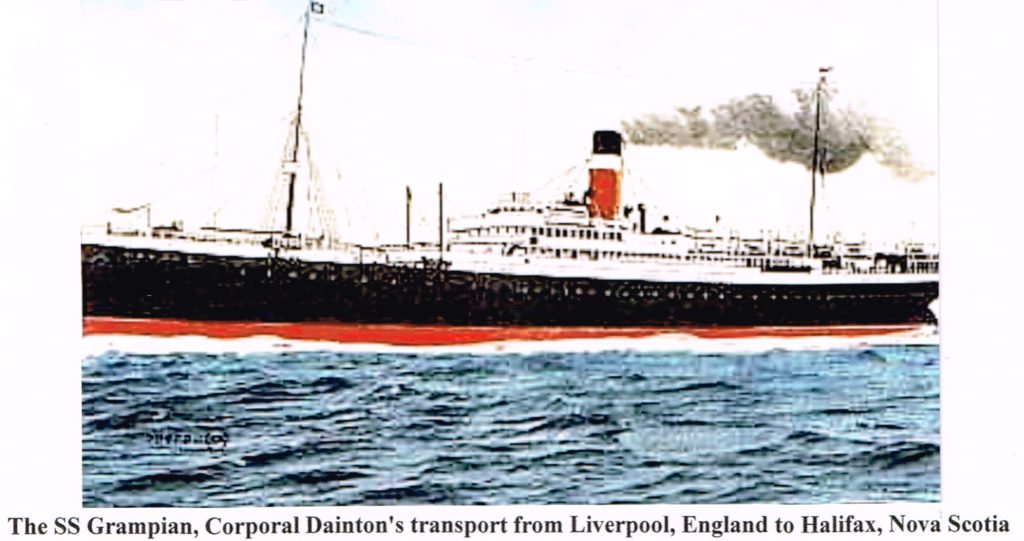MILITARY HISTORY
Corporal Frederick Arthur Dainton – 113161 – ACTIVE SERVICE (World War I)
On July 5, 1915 Frederick Arthur Dainton completed the Attestation Paper for the Canadian Army, Canadian Expeditionary Force (CEF). He was 31 years and 5 months old when, as a married man, he enlisted for the duration of the War. Frederick Arthur was born in London, England, and gave his birth-date as January 13, 1884. On his Attestation Paper, Frederick indicated that he presently belonged to ”A” Company 57th Peterborough Regiment and he had been with it for one year. There is nothing on his File to indicate where he was educated or to what level. As far as employment is concerned, he lists Painter. Frederick Arthur was 5′ 7” tall, 38″ chest (expanded); his weight is not listed. He had a fair complexion, with blue eyes and light brown hair. Frederick Arthur’s Medical Examination was completed in Peterborough, Ontario. In spite of having a “scar inside calf of left leg”, overall, he was deemed fit for Overseas duty with the Canadian Army. His next-of-kin was listed as his wife, Mrs. Violet Rachel Dainton, of Peterborough. Frederick Arthur Dainton signed the Oath and Certificate of Attestation July 5, 1915, in Peterborough. The Certificate of Magistrate was signed by the Justice on July 22, 1915. Frederick Arthur Dainton was taken-on-strength, as a Private (Pte), with the 57th Peterborough Regiment, in Peterborough and was assigned Regimental Number 113161.
The 8th Regiment, Canadian Mounted Rifles was authorized August 6, 1914 and mobilization was authorized December 1, 1914 and mobilized at Ottawa, Military District No 3. The Regiment was recruited by A Squadron in Ottawa, B Squadron in Peterborough and C Squadron in Toronto. On July 23, 1915 Pte Dainton is shown with the B Squad, 8th Regiment, Canadian Mounted Rifles (CMR) which came from the 57th Regiment. The 8th Regiment, Canadian Mounted Rifles was absorbed January 28, 29, 1916 into the 4th Battalion, Canadian Mounted Rifles and the 39th Battalion (Bn).
Pte Dainton embarked from Halifax about October 9, 1915 aboard the SS Missanabie, disembarking in England on October 19, 1915.
Pte Dainton was Present at a Muster Parade at Bramshott Camp, on November 5, 1915.
On January 28, 1916 he was shown as transferred for Overseas Service (embarked) with the 8th Infantry Brigade. January 29, 1916 he disembarked in France and was attached from the 8th Canadian Infantry Brigade and taken-on-strength with the 4th Battalion, Canadian Mounted Rifles 4th (Bn CMR) at the Canadian Base Depot (CBD) at Le Havre. Pte Dainton left the CBD for his Unit on February 7, 1916, arriving on February 10, 1916. The 4th Battalion, Canadian Mounted Rifles was attached to the 8th Canadian Infantry Brigade; part of the 3rd Canadian Division.
March 14, 1916 Pte Dainton was at No 74 Canadian Field Ambulance (CFA) with a ”contusion on his knee due to an accidental slip”, as a result of falling into a hole. On the same day, he was transferred to the No 10 Casualty Clearing Station. March 20, 1916 Pte Dainton was admitted to No 3 Canadian General Hospital (CGH) at Boulogue, France with what diagnosed as ”a Synovitis Knee”. On April 4, 1916 Pte Dainton was discharged from No 3 CGH to the Canadian Convalescent Depot (CCD). April 12, 1916, he was discharged to Base Details. May 9, 1916 Pte Dainton was transferred to No 3 Division Rest Station. May 29, 1916 he is shown as suffering from the effects of ”shell shock”. Pte Dainton claimed that he had been blown up by a shell and was unconscious for 24 hours. On July 4, 1916 after being declared fit for duty, he rejoined his Unit, the 4th Bn CMR.
There are no entries in the Military File from July 4, 1916 to September 16, 1916; as such the War Diary of the 4th Bn CMR was used.
July 1916 – When Pte Dainton rejoined his Unit, they were in billets at Steenvoorde. France. The 5th to 13th was spent in training, with a focus on tactics at the practice trenches, bomb throwing, trench digging, musketry (rifles), and bath parades. On the 14th the 4th Bn CMR marched to billets at the Cavalry Barracks, Ypres. On the same day 100 other ranks joined the Unit. The 15th and 16th the men were detailed in work parties for night work, including out in no-man’s-land. On the 18th, the Bn marched to billets at Zillebreke Bund. The men were once again detailed in work parties from the 19th to 22nd. On the 23rd, the men moved forward and relieved the 5th Bn CMR in the Front-Line trenches at Armagh Wood, near Ypres. The enemy artillery was quite active throughout the the Bn’s stay on the Front, with specific focus placed on Maple Copse, Observatory Ridge, and Sanctuary Wood. Snipers, on both sides, were very active. The Bn sustained a number of losses, and casualties during the tour. The Bn was relieved, by the 58th Cdn Inf Bn on the 28th. The men marched to billets at Erie Camp, near Poperinghe. The men were engaged in bath parades and work parties on the 28th and 29th. The 30th was a day of rest and a divine service was held. On the 31st the Bn marched back to billets at Steenvoorde.
August 1916 – From the 1st to 5th, the 4th Bn CMR was occupied by a great deal of training, and the usual work parties. On the 6th, they relieved the 14th Cdn Inf Bn at Swan Chateaux. The Bn moved forward, on the 9th, and relieved the 5th Bn CMR in the Front-Line. It was reported that the enemy were very quiet, during this tour. On the 16th they were relieved and moved to billets at ”the Bluff”. They were relieved by the 2nd Essex Bn (British) on the 22nd, and marched to billets at North Steenvoorde (Ypres Sector) on the 23rd. The rest of the month, the men was spent in training.
September 1916 – From the 1st to 5th, the 4th Bn CMR remained in billets at North Steenvoorde. On the 6th, they boarded trains which took them to billets at Franqueville, on the Somme, arriving on the 8th. After a day and a half, they were bused, in a circuitous route, arriving at Albert on the 11th, where they marched by platoons to the brick fields, north of the town. On the evening of the 11th, they moved to the Front-Line at Mouquet Farm, near Pozieres, where they relieved the 5th Bn CMR. The enemy bombarded the area with gas shells, while the relief was carried out. The night of the 13th/14th, the Bn was again relieved by the 5th Bn CMR. A general attack, by the 3rd Canadian Division, on Courcelette was launched on the 15th. The new Allied weapon ”the Tank” made its first appearance in this battle. At 5 PM, the Bn was sent forward to push the advantage. By 11PM the situation was under control, with the 4th Bn CMR in front of the Zollern Redoubt. September 16, 1916, Pte Dainton was admitted at the No 3 Canadian General Hospital with Influenza.
October 1916 – On October 5, 1916 Pte Dainton was transferred to the No 14 Stationary Hospital, at Boulogne, where men with infectious diseases were treated. On October 24, 1916, he was transferred to England to the Cdn Casualty Assembly Centre (CCAC) at Southampton, England. On October 25, 1916, he was admitted to the Addington Park War Hospital at Croydon, England with what was diagnosed as ”suspected Enteric Fever”.
January 6, 1917, Pte Dainton was transferred to the Enteric Depot Hospital at Woldingham with what is shown as ”Parathyroid B”, which was a fever brought on by Salmonella poisoning. January 25, 1917, he was transferred to the Canadian Convalescent Hospital Woodcote Park, Epsom, England; he was discharged on February 28, 1917. On March 1, 1917 Pte Dainton was ”reported ex Epsom” and at Hastings. On the same day, he was ”struck-off-strength on transfer to the 2nd Central Ontario Regiment”. March 9, 1917 he was attached from the CCAC to General Audit Office, London, England. On March 24, 1917 Pte Dainton was taken-on-strength to the 2nd Central Ontario Regimental Depot Headquarters Staff, at East Sandling and appointed Acting Corporal (Orderly Room Clerk). May 11, 1917 A/Cpl Dainton was graded as a Clerk. A note indicates that on June 26, 1917 with two plus years of service with the CEF Cpl Dainton was granted and permitted to wear Good Conduct Badge. September 29, 1917 he was ”On Command” to the Canadian Discharge Depot (CDD) pending transport to Canada. On October 18, 1917 Cpl Dainton ceased to be on command with CDD and struck-off-strength on embarking from Liverpool, England under ”Special Authority” aboard the SS Grampian destined for Canada.
October 28, 1917 Cpl Dainton is shown at a Convalescent Home in Kingston, Ontario, Military District No 3. November 5, 1917 he is shown at the MHCC*, Kingston. He was shown as receiving treatment as an Outpatient at Queens Military Hospital where he remained as an Outpatient until January 31, 1918.
*MHCC may stand for “Military Hospital Conveyance Corps” or “Mental Health Coordinating Council”?
Cpl Frederick Arthur Dainton was discharged, at Kingston, Ontario, from the Canadian Army, 4th Battalion, Canadian Mounted Rifles on January 31, 1918, as being medically unfit for further service.
Cpl Frederick Dainton served with the Canadian Army a total of 2 years, 6 months, and 16 days: 3 months and 4 days in Canada, 11 months, 22 days in the UK, and 8 months and 6 days in France.
There is no mention in his File with regards to what Military Medals that Corporal Frederick Arthur Dain-ton was eligible to receive or was awarded. Based on his Military Service, he was awarded the:
British War Medal; and
Victory Medal.
He would have also received the CEF Class “B” War Service Badge.
An excerpt from an article in Maclean’s by Barbara Ameil, September 1996:
”The Military is the single calling in the world with job specifications that include a commitment to die for your nation. What could be more honorable”.
PERSONAL HISTORY
FREDERICK ARTHUR DAINTON
Frederick Arthur Dainton was born on January 18, 1884 in Kensington, London England the son of Arthur William Dainton & Helen Elizabeth Wilson. In 1901 Frederick Arthur worked as a Grocer’s Porter; later he worked as an Insurance Agent. In 1906 Frederick Arthur Dainton and his brother William Henry immigrated to Canada.
Frederick Arthur Dainton married Violet Rachel Bristow, from Kent, England, on June 20, 1913 at the Church of St. John’s in Peterborough, Ontario. Violet Rachel’s parents were Thomas Robert Bristow and Caroline Rachel Smith. Witnesses to marriage were Annie Caroline Bristow of Ashburnham, Peterborough & Thomas Davis of 346 Aylmer St., Peterborough. The wedding ceremony was performed by F. C. Davidson. Frederick and Violet had four children: Arthur Thomas; Margaret H., born August 2, 1914; Audrey Violet born in 1921 and Olive “Patricia” born in 1928. On July 5, 1915, when Frederick enlisted, Violet Rachel was living at 426 George Street, Peterborough, Ontario.
It is believed that sometime after returning from WW I, Frederick Arthur, Violet Rachel and family were living at RR #4, Peterborough on Highway 28 (now County Road 29) just north of the Jack & Jill on Highway 507. It is also believed that Arthur worked at the Canadian General Electric Company in Peterborough. (Paragraph courtesy of Neil Wasson.)
Frederick Arthur Dainton died October 13, 1961 & Violet died February 15, 1979; both are buried in Hillside Cemetery in Lakefield, Ontario with their daughter, Margaret H. Strain nee Dainton; August 2, 1914 – January 27, 1998. Frederick Arthur’s brother William Henry joined the same Unit in WW I but was killed-in-action in 1917.
THE FREDERICK ARTHUR DAINTON FAMILY OF OTONABEE TOWNSHIP
Frederick Arthur Dainton’s parents are Arthur William Dainton born in 1854 & Helen Elizabeth Wilson born in 1877. They lived in Kensington, London England. Arthur and Helen had five children: Ellen “Helen” born in 1877; Edith Alice born in 1880; Florence Dainton born in 1882; Frederick Arthur Dainton, born January 18, 1884 in Kensington, London, England and William Henry Dainton, born September 8, 1886 in London, England. Arthur William Dainton died in 1887 leaving Helen with a young family.


